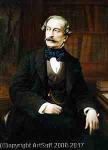Massimo Taparelli Azeglio
Massimo Taparelli Azeglio
สถานที่: Turin
เกิด: 1798
ความตาย: 1866
ชีวประวัติ:
Massimo Taparelli, Marquess of Azeglio (24 October 1798 – 15 January 1866), commonly called Massimo d'Azeglio, was a Piedmontese-Italian statesman, novelist and painter. He was Prime Minister of Sardinia for almost three years, until his rival Camillo Benso, Count of Cavour succeeded him. D'Azeglio was not a liberal or a republican, but a paternal conservative and monarchist who hoped for a federal union between Italian states. As Prime Minister, he consolidated the parliamentary system, getting the young king to accept his constitutional status, and worked hard for a peace treaty with Austria. Although himself a Roman Catholic, he introduced freedom of worship, supported public education, and sought to reduce the power of the clergy in local political affairs. As senator, following the annexation of the United Provinces of Central Italy, Azeglio attempted to reconcile the Vatican with the new Italian Kingdom. His brother Luigi Taparelli D’Azeglio was a Jesuit priest.
Massimo Taparelli, Marquis d'Azeglio, was born in Turin on 24 October 1798. He was descended from an ancient and noble Piedmontese family. His father, Cesare d'Azeglio, an officer in the Piedmontese army, held a high position at court. On the return of Pope Pius VII to Rome after the fall of Napoleon, Cesare was sent as special envoy to the Holy See and took his son, then sixteen years of age, with him as an extra attaché. Young Massimo was given a commission in a cavalry regiment, which he soon relinquished on account of his health. During his residence in Rome, Massimo acquired a love for art and music and decided to become a painter, to the horror of his conservative, aristocratic family. His father reluctantly consented, and Massimo settled in Rome, devoting himself to art.
He led an abstemious life in Rome, maintaining himself by painting Romantic landscapes which frequently included historical subjects. He also painted scenes for a self-composed opera. In 1830 he returned to Turin and, after his father's death in 1831, moved to Milan. He resided in Milan for twelve years, moving in the city's literary and artistic circles and, in 1834, helped to organise the Salotto Maffei salon, hosted by Clara Maffei. He became an intimate of Alessandro Manzoni the novelist, whose daughter he married. At that point, literature instead of art became his chief occupation; he produced two historical novels, Niccolò dei Lapi and Ettore Fieramosca, in imitation of Walter Scott. The novels had a strong political context, with d'Azeglio aiming to illustrate the evils of foreign domination in Italy and to reawaken national feeling.
In 1845 d'Azeglio visited Romagna as an unauthorized political envoy, to report on its conditions and the troubles which he foresaw would break out on the death of Pope Gregory XVI. The following year he published his famous pamphlet Degli ultimi casi di Romagna at Florence; as a consequence of this he was expelled from Tuscany. He spent the next few months in Rome, sharing the general enthusiasm over the supposed liberalism of the new pope, Pius IX; like Vincenzo Gioberti he believed in an Italian confederation under papal auspices and was opposed to the Radical wing of the Liberal party. His political activity increased and he wrote various other pamphlets, among which was I lutti di Lombardia (1848).
On the outbreak of the first war of independence, d'Azeglio donned the papal uniform and took part under General Durando in the defence of Vicenza, where he was severely wounded. He retired to Florence to recover, but as he opposed the ruling democrats he was expelled from Tuscany a second time. He was now a famous man, and early in 1849 Charles Albert, king of Sardinia, invited him to form a cabinet. Realizing how impossible it was to renew the campaign, but "not having the heart to sign, in such wretched internal and external conditions, a treaty of peace with Austria" (Correspondance politique, by E Rendu), he refused.
After the defeat at the Battle of Novara (23 March 1849), Charles Albert abdicated and was succeeded by Victor Emmanuel II. D'Azeglio was again called on to form a cabinet; this time, although the situation was even more difficult, he accepted, concluded a peace treaty, dissolved the Chamber and summoned a new one to ratify it. The treaty was accepted and d'Azeglio continued in office for the next three years. While all the rest of Italy was a prey to despotism, in Piedmont the king maintained the constitution intact in the face of a general wave of reaction. D'Azeglio conducted the country's affairs with tact and ability, and improved its diplomatic relations. With his top aide Cavour taking the lead legislation passed weakening the powers of the Church to own land, control the schools and supervise marriage laws. When the bishops protested they were punished or exiled, inspiring liberal anticlerical elements across Italy.
He invited Count Camillo Cavour, then a rising young politician, to enter the ministry in 1850. Cavour and Farini, also a member of the cabinet, made certain declarations in the Chamber (May 1852) which led the ministry in the direction of an alliance with Rattazzi and the Left. D'Azeglio disapproved of this and resigned office, but on the king's request formed a new ministry, excluding both Cavour and Farini. In October, however, owing to ill health and dissatisfaction with some of his colleagues, and for other reasons not quite clear, he resigned once more and retired, suggesting to the king that Cavour should be his successor.
More...
Wikipedia link: Click Here

